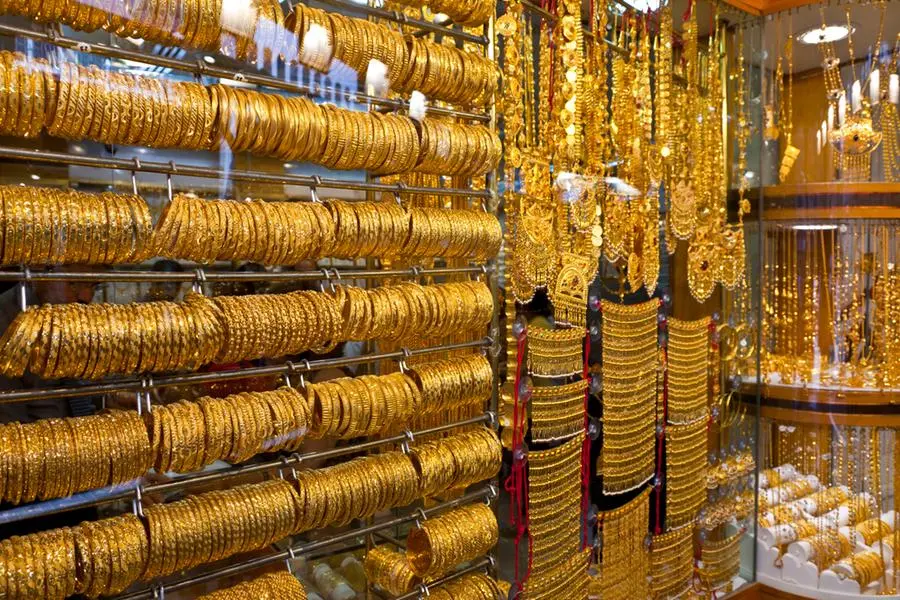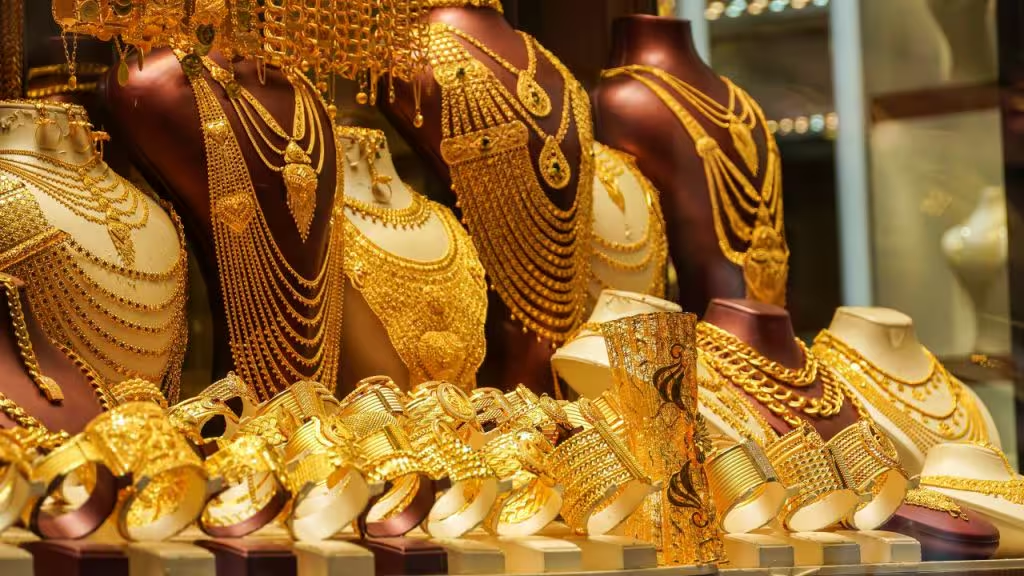In a stunning turn of events, Dubai has witnessed the second-highest gold price surge of 2025, as escalating tensions in the Middle East send shockwaves through global markets. As the geopolitical spotlight turned once again to the volatile Israel-Iran relationship, investors across the UAE found themselves at the heart of a global gold rush.
The price of 24-carat gold in Dubai surged by AED 4 per gram, reaching AED 412.75 — just shy of the record AED 420 mark hit earlier this year. This dramatic rise followed closely on the heels of Israel’s most significant airstrike on Iranian territory in decades, igniting regional fears and triggering a classic flight to safety in gold.
The Chain Reaction: From Conflict to Commodities
It started with an unexpected overnight escalation. In a calculated move, Israel launched a precision strike targeting suspected Iranian military and nuclear infrastructure. The attack immediately provoked retaliatory action, with Iranian forces deploying ballistic missiles and drones in a rare open confrontation.

This rapid escalation of conflict created an atmosphere of deep uncertainty. Financial markets responded with swift adjustments. Oil prices spiked, global equity indices dipped sharply, and gold — historically the most trusted safe-haven asset — rallied with force.
The impact was instant and far-reaching. In Dubai, one of the world’s most influential gold trading hubs, retailers reported a rush of investor interest. With rising global anxiety and inflationary concerns already simmering, the strike acted as a catalyst that pushed bullion prices to new 2025 highs.
Investors Turn to Gold in Search of Safety
For investors, the message was clear: safety first. With the threat of a larger Middle East conflict looming, and global stock markets showing early signs of instability, capital quickly began flowing into gold. The yellow metal, prized not only for its intrinsic value but also for its stability in turbulent times, became the asset of choice.
Central to this movement is Dubai’s role as a global gold trading hub. Dubai’s accessibility, tax-free gold buying structure, and strategic geographic position have always attracted international buyers. With prices on the move, everyone from large-scale traders to small individual investors started repositioning their portfolios.
What’s particularly significant is that this surge wasn’t solely due to the conflict. Simultaneously, global economic signals added fuel to the fire. The U.S. Federal Reserve hinted at a possible policy easing, following signs of cooling inflation and rising unemployment data. This shift reduced yields on government bonds, making non-yielding assets like gold more attractive by comparison.
As a result, gold prices globally climbed between 1.3% to 1.7% in a single day — a substantial rally by commodity standards — bringing them within reach of the $3,500 per ounce record highs set earlier this year.
Oil Surges, Equities Stumble

The spike in gold prices didn’t occur in isolation. Oil markets also reacted strongly, with crude oil climbing nearly 6% in intraday trading, driven by fears that any expansion of the conflict could endanger shipping routes like the Strait of Hormuz — a critical artery for global oil supply.
Meanwhile, equity markets took a hit. Wall Street recorded its biggest single-day drop in three months, while Asian and European indices followed suit. In the Middle East, regional stock exchanges experienced immediate dips, with Dubai’s DFM falling by nearly 2% amid heightened investor anxiety.
This interconnection of markets — where geopolitical instability, commodity prices, and economic indicators all influence each other — created a domino effect that was felt from Tehran to Times Square.
How the Price Hike Affects Everyday People
Beyond traders and investors, the gold price surge has real-world consequences for everyday people in Dubai and across the UAE. For those planning weddings, festivals, or traditional ceremonies — all of which often include gold gifting — this price increase presents a financial challenge.
Jewellery retailers in Dubai’s Gold Souk reported an immediate dip in consumer demand following the announcement. Customers, especially those with limited budgets, have started postponing purchases in hopes of a correction. For small businesses and local artisans, the sharp rise means a sudden jump in material costs, compressing profit margins and forcing price revisions.
However, not all effects are negative. For gold investors who bought earlier this year, the rally has translated into solid short-term gains. Many are taking this opportunity to liquidate positions and secure profits, especially with uncertainty still clouding the horizon.
What’s Driving Sentiment Now?
Market watchers point to a unique convergence of events driving this gold rally. First, the geopolitical tension is real and escalating, and history suggests that such flare-ups in the Middle East often trigger long-lasting commodity shifts.
Second, macroeconomic data has tilted investor sentiment toward assets that perform well in uncertainty. With inflation cooling in the West and global economic growth slowing, the focus is now on wealth preservation rather than aggressive risk-taking. Gold, in this environment, is more than just a commodity — it becomes a statement of caution.
Third, the very structure of global finance — with growing debt levels, fragile currencies, and elevated geopolitical risk — is reinforcing the allure of tangible assets. Digital investors, too, are increasingly seeking diversification through physical or tokenised gold investments.
Looking Ahead: Will the Rally Last?
The big question for both seasoned investors and curious observers is: how long will this rally last?
That depends on several variables. If the Israel-Iran conflict escalates further or draws in regional players, the price could surge even higher. Conversely, if diplomatic negotiations or international pressure ease tensions, markets may stabilise, and gold could retrace.

Similarly, central bank policies remain crucial. Should the U.S. Federal Reserve or other global banks move toward interest rate cuts, we could see continued upside in gold. However, any surprise policy tightening would likely suppress the rally.
In Dubai specifically, much will also hinge on consumer behaviour. If high prices persist, it may dampen local jewellery sales — a key component of the city’s gold ecosystem. But for now, the momentum appears strong.
The Human Element Behind Market Moves
It’s easy to get lost in data — grams, dollars, yields, and charts. But behind every gold price spike are stories. A father postponing his daughter’s wedding because the necklace set became 10% more expensive overnight. A small-time investor watching his savings grow in value with mixed relief and anxiety. A jeweller recalibrating daily operations to keep the doors open while maintaining margins.
These are the human faces behind market numbers. In the heart of Dubai’s gold district, emotions are running just as high as the prices — from thrill and triumph to worry and hesitation. For many, this moment is more than just an economic headline. It’s a lived experience shaped by the unpredictable tides of politics, finance, and fate.
Conclusion: A Moment That Defines 2025?
The latest gold price surge in Dubai is more than just a spike — it’s a symbol of the era we’re living in. An era where geopolitics and global finance are so intricately linked that a military strike can send waves across continents in seconds.
It’s also a reminder that in an increasingly digital and unstable world, the timeless appeal of gold endures. Whether worn as jewellery, held as bullion, or traded in futures markets, gold continues to shine brightly in moments of darkness.
For now, all eyes remain on the Middle East. But for Dubai’s gold traders, jewellers, and everyday investors, the message is clear — the golden age of uncertainty is very much here.
Do follow UAE Stories on Instagram
Read More: Explosive Defence Scam: Dubai Kingpin and Ex-MP’s Secret Ties













